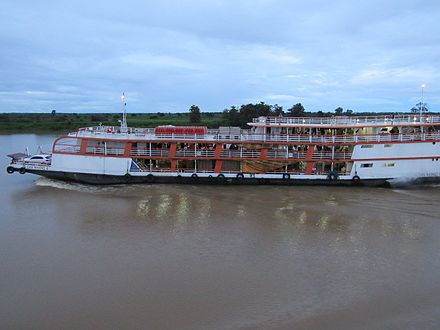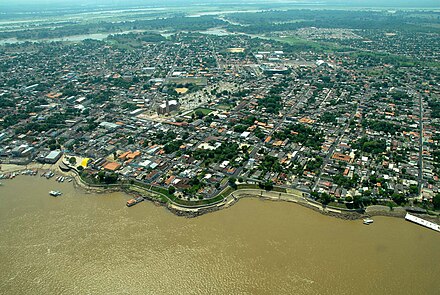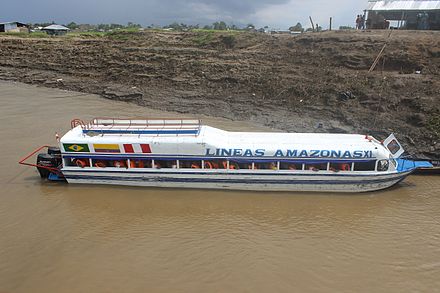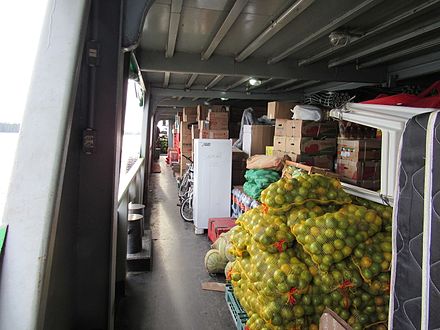Voyaging along the Amazon River - river in South America
This itinerary details travelling downstream on the Amazon from Iquitos via Tabatinga, Manaus, Santarém, Santana/Macapá to Belem. This article does not point out sights along the river as for most people the journey itself is the main attraction. For sights along this trip, check out the pages specific to locations mentioned.

If you are traveling upstream most of this information still applies to you but you'll have to nearly double the price and duration. You'll have to check the departure dates and times (please update this page with them too!).
The full trip will take roughly 8 days downstream and 14 days upstream, though adding at least 2 or 3 days buffer is recommended to allow for delays and missed connections. You can also cut the journey short by starting somewhere in between or by doing some legs by plane. See the Get In-section for details. Another way to save some time is to do parts by speed boat, though be aware that seating is like in an airplane's cattle class.
Furthermore, travel time depends on the season of the year. In the rainy season, the boats can go pretty fast, while in the dry season, they sometimes lose a few hours because they have to reverse until they find a passage where water is deep enough. Last but not least, travel time also depends on the itinerary of the boat. If a boat stops in lots of small settlements you might have to watch the crew get a cow on board which is to be sold in the next large city - this endeavor can take anywhere from 10 minutes to 5 hours.
Understand that you cannot plan the trip in detail: For ease of mind, accept that you can only go step by step and that, in the worst case, you'll be stuck in a place for 2 or 3 days until the next boat leaves to your next destination.
Understand
The boats that serve the Amazon are not designed with tourists in mind; they are the default mode of transportation for goods and people from place A to place B. Therefore:
- always ask how long the boat will be in a port before leaving the boat. Somebody who manages the off-loading with a list in his hand gives you a more precise answer about when the boat is going to depart.
- never venture too far from the boat when in a port, it will not wait for you to return
- boats are not made for comfort, they are noisy and don't offer a lot of service
- standards are low, reflecting the standard of living of the people who use those boats (those who have money to spare prefer to fly)
- western people will stand out as "gringos", expect to be asked for favors (money, cigarettes, etc.) - a friendly "no" is usually accepted, though
- your fellow travelers are mostly poor - don't flash expensive gear or, if you have to (like a camera), keep it on you all the time (i.e. sleep with the camera in your hammock, take it with you when going to the shower or toilet). The other travelers have at least the same moral standards you have, but when stealing a camera from you is the equivalent of half a year of hard, honest work, temptations are high and after all "you can afford to buy a new one".
But if you accept all that, you can have a great time - just don't put your expectations too high and you'll probably be pleasantly surprised.
Prepare
At home, or en route, if traveling for longer: Get a yellow fever vaccination. In theory it is mandatory in the tres fronteiras area where Brazil, Colombia and Peru meet, practically yellow fever is endemic along most of the Amazon and getting a vaccination upfront is better than having complications after an infection. Also, some countries require proof of vaccination when coming from an area where it is endemic (again in theory, it is rarely checked in reality). Still, get vaccinated!
Also, especially when planning lots of excursions on lands and when traveling for a longer time, get a typhus vaccination.
Last but not least: When traveling to riskier areas (esp. the north-eastern parts like the border to Venezuela or to the Guyanas), bringing emergency medication for malaria is a very good idea.
If you want to pay on board the ticket as well as food and drinks with a credit card, ask beforehand if that is possible. Some boats only accept cash.
You'll need a number of things on the boats
- Hammocks and ropes: (Portuguese: redes e cordas) R$20-120 + $2.5, as of 2016. There are many different types available, just remember that it's going to be hot during the day and can get quite cold and windy at night. So best to get one with thin material and use your sleeping bag at night or get a thick one and a blanket (sold in the same shops, ca R$20). A hammock for 2 will allow for much more comfortable sleep when used by one person only. Most boats don't allow couples to share a hammock: get one per person (though kids may sleep in a parent's hammock).
- Bed sheet and blanket: If you decide to take a cabin or suite, you cannot rely on having more than a mattress. Bring your own sheet and blanket.
- Mosquito nets and insect repellents: Locals don't use nets even in wet season, but applying insect repellent at sunset and again before going to bed is a good idea to keep all kinds of insects, not just mosquitoes, away.
- Power plug adapters: All boats have power sockets but random plugs. Voltages differ. Though, don't count on having access to power all the time - there are many passengers and only so many power plugs. Thus, don't expect to use your laptop or smartphone permanently to pass the time...
- Sun milk and a hat: Even in rainy season the sun is strong, doubly so because it is reflected by the water. It is easy to get sun-burned because the breeze on the river will make it feel less strong. See the general sun burn article for more information.
- Rubber flip flops: The sanitary conditions in toilets and showers are not the best, you want to wear shoes in both.
- Ear plugs: Light sleepers definitely will want those to block out the noise of the engine, loud TVs or merchants who try to sell you cheese at 05:30.
- Toilet paper: Usually provided, but it is still a good idea to have an emergency supply, alternatively handkerchiefs.
- Cutlery: On some boats you are handed brittle plastic knives, forks and spoons. Do like some locals do and bring your own metal cutlery!
A good idea to have are:
- (e-)Books, cards, dominoes: You will inevitably get bored at some point - so will the other passengers. Bringing some games will help you pass the time and make connections with other travelers.
- Beer and liquor: Those are pretty expensive on the boats so bring your own stash. Evenings tend to turn into parties and you'll make lots of friends fast when you can contribute a bottle of good Pisco or Cachaca. (Though on very few boats alcohol is prohibited, e.g. on F/B Diamante that serves the Manaus—Tabatinga route.)
- Cigarettes and lighters: If you are a smoker, stock up. Sometimes you can buy both on the boat, sometimes only one of these items will be avaiable.
- Offline translation: Google Translate offers it between Portuguese and English. So you can communicate more easily as almost nobody on the boat speaks English and while there is no mobile internet on the trip.
Get in
Depending on your citizenship you may need a visa to enter Brazil, Peru and Colombia. Ensure that you get your passport stamped as might be checked numerous times (esp. when traveling downstream) and penalty fees can be steep when you try to leave a country and cannot show your entry stamp.
The only exception is the Tres Fronteras area where Peru, Brazil and Colombia meet - here you can freely roam around the three countries. You'll still have to make sure you get your entry- and exit stamp for the country you are coming from and the one you are going to.
By plane
You can get to: Belem, Macapa, Santarem, Manaus, Tabatinga, Leticia and Iquitos.
Belem's international airport (IATA: BEL) has flights to Lisbon, Miami Airport, Paramaribo, Georgetown and Cayenne.
Macapa's airport (IATA: MCP) has flights to Belém and Brasilia.
Santarem's airport (IATA: STM) has flights to Brasilia, Fortaleza, Manaus and Rio de Janeiro.
Manaus's airport (IATA: MAO) has flights to Miami, Barcelona El Prat, Panama City, Fortaleza and Aruba.
Tabatinga's airport (IATA: TBT has flights to Manaus.
Leticia's airport (IATA: LET) has flights to Bogotá, Iquitos and Pucallpa.
Iquitos's airport (IATA: IQT) has flights to Lima, Trujillo, Pucallpa and Chiclayo.
By bus
You can reach Belem (by bus from the south), Macapa (from French Guyana via Oiapoque) and Manaus (by bus from Boa Vista).
By boat
You can go to Iquitos from further south in Peru, though as of 2016 this is only recommended to seasoned travelers because of drug-related violence along the 4-day trip within Peru.
Go
Prices depend on season and those listed below (from 2016) the prices you'll be quoted will likely be different. As a rule of thumb: per day of travel you'll have to pay R$50 per day for a passage in a hammock in low season, R$60 to R$70 in high season - without food. If food is included, the price is R$15 to R$25 higher per day. If food is extra, calculate with R$15 to R$30 per day for full board.
Note that the following itinerary is just listing major towns/settlements. You can get get off the boat at any point in between and board another one later. Just book exactly until where you want to go, as none of the boats offers hop-on-and-off tickets.
For most efficient connections buy your onward ticket immediately after getting off a boat, directly at the port after disembarking.
The following information is just a rough guide, details depend on which boat you take at which season and to which destination.
Boat schedules usually have a buffer at every stop so they can make up time lost earlier by speedier unloading of goods. Though, sometimes boats arrive and leave earlier than indicated by the schedule! Always be early at the port, give the booking agency your telephone number (or the one of your hotel) so they can inform you of earlier departures. In case boats arrive early at their final destination one usually can sleep on the boat until sunrise - but don't count on it, in worst case you'll have to leave the boat at 03:00 in heavy rain.
Peru
In theory prices are set. In reality you will be quoted (slightly) higher prices if you are a gringo. Whether to discuss or just accept is a matter of personal preference and how well you speak Spanish.
Iquitos to Santa Rosa (Peru) - 11 hours to 2½ days
You can either take a speedboat (11 hr) or a slow boat (about 2½ days). The latter will do many stops in small settlements along the river to take on and drop off passengers and cargo.
- Stops: Pebas and various smaller cities
Santa Rosa (Peru) to Tabatinga (Brazil) - 10 minutes plus bureaucracy
First, get your exit-stamp for Peru at the immigration office in Santa Rosa. Then you will have to take a small boat to Tabatinga (about 10 minutes). They wait about 200 m downstream from the place where the larger boats stop.
In Tabatinga, you have to see immigration in town to get your entry stamp into Brazil. In both settlements it is advisable to take a taxi to do the immigration formalities. In Santa Rosa, it will help allow you to avoid walking through mud, in Tabatinga you avoid length walks through boring neighborhoods.
Santa Rosa (Peru) to Leticia (Colombia) - 10 minutes plus bureaucracy
First, get your exit-stamp for Peru at the immigration office in Santa Rosa. Then you will have to take a small boat to Leticia (about 10 minutes). They wait about 200 m downstream from the place where the larger boats stop.
In Leticia, you have to see immigration at the airport to get your entry stamp into Colombia. In both settlements it is advisable to take a taxi to do the immigration formalities. In Santa Rosa, it will help allow you to avoid walking through mud, in Leticia you avoid a pretty long walk to the airport.
This mostly applies to people who want to end their Amazon river tour here, because:
- If you only want to go to Leticia to see it but plan to travel on downstream into Brazil, do not get an entry stamp for Colombia. If you show up the next day again for your exit stamp you will probably annoy the customs officials plus waste money on taxi for two trips to the airport!
- If you plan to stay only for one or two days and then fly out of Leticia, you don't have to get your entry stamp immediately - just get it when going to the airport.
- If you want to do a jungle tour from Leticia but want to go downstream the Amazon afterwards, you also can just get an entry stamp for Brazil, ignoring Colombian immigration. You may roam freely in that area as long as you have a valid stamp in your passport for any of the three countries. (Double check with your tour operator - they will be able to tell you whether you can skip immigration or not!)
Brazil
, capital of the state of Amazonas, Brazil.](https://upload.wikimedia.org/wikipedia/commons/thumb/7/75/Port_of_Manaus%2C_Brazil.jpg/440px-Port_of_Manaus,_Brazil.jpg)
Unlike travelling the Peruvian Amazon, in Brazil the prices per voyage are set and it's extremely unlikely that you'll be ripped off.
Major stops going downstream are Tabatinga, Manaus, Óbidos, Santarém, Macapá and Belém, from west to east.
Tabatinga to Manaus - 3 days downstream, 4 to 6 days upstream
- Boat: Itaberaba I or II, Itapuranga, Diamante among others
- Cost: Hammock space for R$240/R$400 upstream, cabin or suite for R$1,200/R$1,500 upstream, two sharing. Both options include all meals and drinking water. All stated prices are as of June 2021.
- Departure: 12:00 (selected days!) - Navegam covers this route and shows you the schedules. Or check the photos section (really) of their Facebook page for schedules
- Stops: Benjamin Constant, São Paulo de Olivença, Amaturá, Santo Antônio do Içá, Tonantins, Jutaí and Fonte Boa.

Lunch on the first day isn't included, but shortly after departing the boat will stop in Benjamin Constant - for more cargo and passengers - where locals will jump aboard to sell lunch boxes (R$6-15) and drinks.
Manaus to Belém - 80 hours downstream, 120 hours upstream
- Cost: R$220 (without food, as of 2016)
This section of the journey is a little bit slower as the flow of the river is not very strong but it is much more beautiful. Especially on the final day. You can stay on the boat after arrival and sleep in your hammock until morning. If you're heading to French Guiana it's best to get up early though!
_(10746398856).jpg/440px-Itacoatiara_(AM)_(10746398856).jpg)
Manaus to Santarém - 36 hours downstream, 60 hours upstream
- Boat: Numerous
- Fastboat: 13 hours, R$250, departs every Wednesday at 06:00, arrives at 20:00;
- Slowboat: 29 hours, R$80, departs Tuesday at 11:00, arrives at 20:00 the next day (night in your own hammock)
Manaus to Óbidos (Brazil) - 29 hours
- Cost: Hammock space (R$70, as of 2016) and cabins. Both options include all meals and drinking water.
- Departure: Daily at 23:30
- Stops: Parintins, Juruti and Oriximiná
Óbidos (Brazil) to Santarém - 6 hours
- Cost: Hammock space (R$140, as of 2016) and cabins. No meals included.
- Departure: Daily at 22:00/23:00
- Stops: Curuá and Alenquer
in the state of Pará.](https://upload.wikimedia.org/wikipedia/commons/thumb/8/8d/Encontro_das_%C3%81guas_Tapaj%C3%B3s-Amazonas_Santar%C3%A9m.jpg/440px-Encontro_das_Águas_Tapajós-Amazonas_Santarém.jpg)
Santarém to Santana/Macapá - 29 hours
- Cost: Hammock space (R$140, as of 2016) and cabins. Both options include all meals and drinking water.
- Departure: Daily at 18:00
- Stops: Monte Alegre, Prainha and Almeirim
Santana/Macapá to Belém - 24 hr downstream, 30 to 35 hr upstream
- Boat: Daily at least one
- Cost: Hammocks (R$100), cabins and suites (R$250/pp) (as of 2016)
- Departure: around 10:00
Eat
On some boats food is included, while on others one has to sometimes pay prices which would be considered steep for the locals. Ask when booking and maybe stock up on durable food so you don't have to pay 3 times a day for sometimes mediocre food.
Going rates, as of 2016, are: R$3 to R$5 for breakfast, R$10 to R$12 for lunch and dinner. Simple sandwiches that are available on some boats' bars go for R$4. Softdrinks (0.33l can) come at R$4, beers (0.33l can) come at R$5.
The quality of the food depends on the boat and cannot reliably be predicted. R$5 for breakfast can get you a single coffee and a roll with ham and cheese or, on another boat, the same plus lots of fruit and a cup of a hot, delicious, milky something.
Lunch and dinner are often rice (maybe with noodles or beans or both), some salad and some meat. In the worst case it will be chicken every time, but on some boats one has a choice between chicken, beef and pork. In the Peruvian section of the Amazon, fish might also be served.
One can also rely on merchants coming on board and offering fresh or pickled fruit, fried food and sweets.
Do
You could discover the area around with brought binoculars.
You can ask the crew if they planned something during the trip. It could be, that the crew throws somewhere bags of chips into the water, which are then grabbed by children in kayaks.
You can ask one of the boat captains at what time the speed boats overtakes the slow boat approximately. Or at what time a boat from the opposite direction is going to meet your boat. Around that time you can wait for it.
The Amazonas has several antipode areas with Malaysia and Indonesia. With the GPS on your smartphone you can check, if you actually pass a village on the exact opposite side of the earth. The Android app "Pantipodes" and the iOS app "Antipodes - Opposite Points" make it possible.
Sleep
On most boats you have several kinds of accommodation to chose from:
- Hammock: All boats offer space for hanging your hammock. This is what most people do.
- Cabin: All but the smallest boats offer cabins which are tiny rooms with bunk beds. Some come with air-condition (and maybe an extra charge for using it), some come with, some without sheets. Stated prices for cabins are always per person and if you don't pay for 2 people someone might be put into the other bed in your cabin. The main advantage of cabins is that one can lock them, so if traveling with expensive gear, one should consider getting one for the gear (and still sleep in a hammock outside).
- Suite: Larger boats have suites, which are slightly larger cabins with private toilet and shower. They cost about 5 times as much as a space in a hammock but are a good choice for people who don't want to deal with the sometimes disgusting public toilets and showers.
- Master Suite: Suites with a view, even more expensive. Only available on very few boats.
Note that, usually, neither cabins nor suites have windows and can become very moist without air-condition and/or regular airing.
It's not a good idea to be tight and use your sleeping mat instead. People will be walking over you or someone will put their hammock 10cm above you. Or it starts to rain and you wake up soaked to the bones.
Hanging your hammock
This warrants its own section - there is more involved than one might think.
- Be early to get a good spot. The best time is 5 minutes after the boat arrives since all the locals will do the same.
- Avoid places close to sources of noise and smells: TV, toilet, bar, restaurant, boat engine.
- Don't use too much space. Especially when traveling in a group it is tempting to mark your area and leave lots of space between your hammocks. Don't. A good rule of thumb is to space hammocks like the others do. If you don't, someone might just put his hammock in between, move your hammock or even put his above yours.
- Hang it low. The lower it hangs, the less painful the fall if your knots fail.
- If you need help securing your hammock just ask the person next to you or simply look lost - people will help you.
- On some boats there is prominent signage stating that couples are not allowed in the same hammock.



